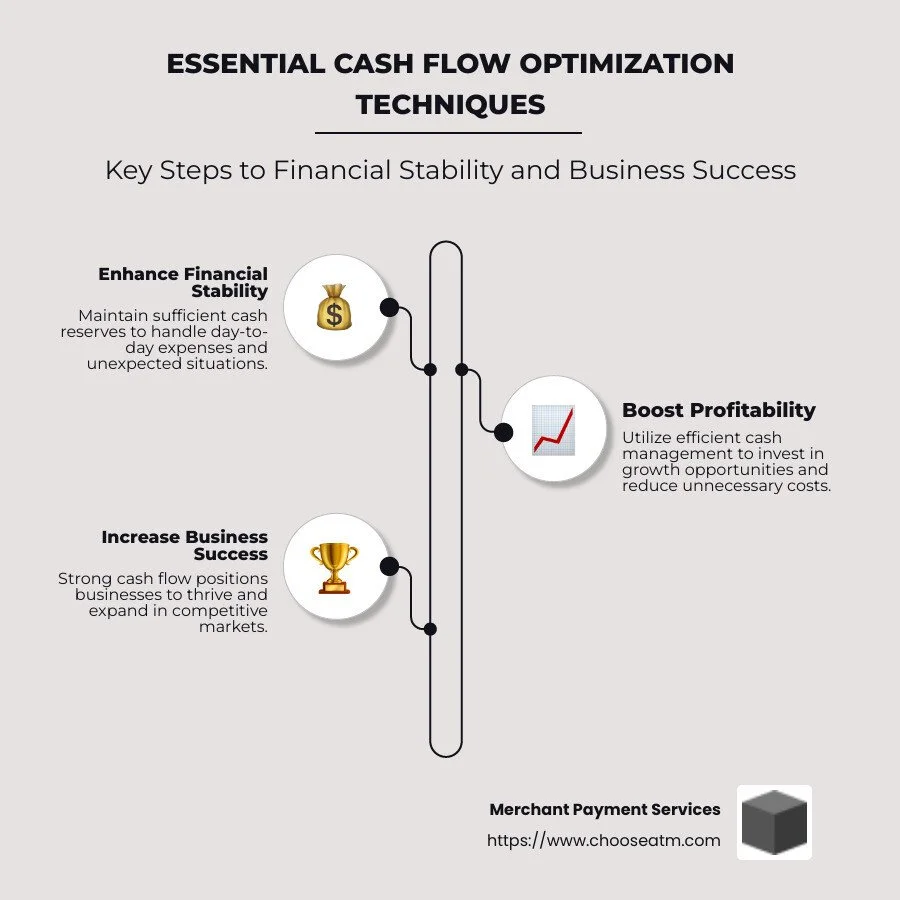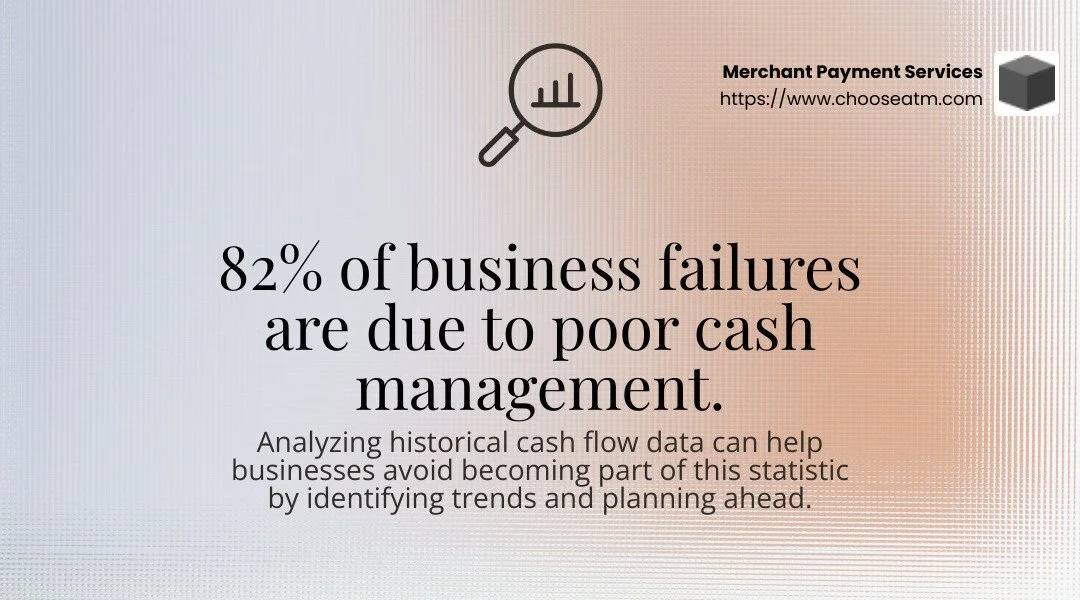Cash Flow Mastery: Techniques for Optimal Management
Cash flow optimization techniques are vital for ensuring the financial health and success of any business. They're particularly essential for small businesses striving for profitability amidst fluctuating market conditions. By optimizing cash flow, businesses can achieve several benefits:
Improve financial stability: Having sufficient cash reserves ensures that you can meet day-to-day expenses and handle unexpected situations.
Boost profitability: Efficient cash management allows for investment in growth opportunities, increasing sales and reducing unnecessary costs.
Increase business success: A strong cash flow positions businesses to thrive and expand.
Without proper cash flow management, companies risk going bankrupt—even if they appear profitable on paper. As highlighted during the pandemic, 65% of small businesses struggled or failed to cover operational expenses due to cash flow issues. This underscores the importance of mastering cash flow to safeguard your business's future and profitability.
I am Lydia Valberg, co-owner of Merchant Payment Services, a company built on trust and excellence with over 35 years of experience. My expertise in cash flow optimization techniques is deeply rooted in practical solutions, ensuring businesses like yours achieve financial stability and long-term success.
Understanding Cash Flow Optimization
Cash flow optimization is all about making sure your business has enough money coming in and going out at the right times. This involves a few key areas: cash flow analysis, cash inflows, cash outflows, and the timing of cash flows.
Cash Flow Analysis
First, let's talk about cash flow analysis. This is like taking a close look at your business's money health. You want to see where your money is coming from and where it's going. By doing this, you can spot any patterns or problems and figure out how to fix them. Think of it as a financial check-up.
Cash Inflows and Outflows
Next, we have cash inflows and outflows. Cash inflows are all the money coming into your business. This could be from selling products, providing services, or even from investments. Cash outflows, on the other hand, are all the money going out. This includes paying bills, salaries, and buying supplies.
Here's a simple way to remember it:
Inflows = Money in
Outflows = Money out
The goal is to have more inflows than outflows so your business stays healthy and can grow.
Timing of Cash Flows
Timing is everything in cash flow optimization. Even if you have lots of money coming in, if it doesn't arrive when you need it, you could run into trouble. For example, if your bills are due before your customers pay you, you might struggle to cover your expenses.
To manage this, businesses often look at their revenue seasonality. This means understanding when your sales might be higher or lower throughout the year. By predicting these patterns, you can plan better and avoid cash flow problems.
In summary, understanding cash flow optimization means keeping a close eye on your cash flows and making sure they are well-timed. This ensures your business can meet its obligations and seize opportunities for growth.
Cash Flow Optimization Techniques
When it comes to cash flow optimization techniques, there are several strategies that can help your business maintain a healthy cash flow. Let's explore some of these techniques:
Lease, Don't Buy
Leasing instead of buying can be a smart move for businesses looking to preserve cash. When you lease equipment or property, you pay in smaller, manageable increments. This approach keeps more cash available for day-to-day operations. Plus, lease payments are typically considered a business expense, which can be written off on taxes.
Offer Discounts for Early Payment
Encouraging customers to pay early can significantly boost your cash flow. By offering an incentive, like a small discount, you motivate customers to settle their bills sooner. This accelerates cash inflows, ensuring you have the funds when you need them most.
Conduct Customer Credit Checks
Before extending credit to customers, it's crucial to check their creditworthiness. A customer with poor credit can delay payments, hurting your cash flow. By conducting credit checks, you ensure payment reliability and reduce the risk of late payments. If you decide to work with a high-risk customer, consider higher interest rates to compensate for potential delays.
Improve Inventory Management
Effective inventory management is key to optimizing cash flow. Start by forecasting your inventory needs accurately. Identify fast-moving products and prioritize them. This helps maintain optimal stock levels, reducing the cash tied up in unsold inventory.
If certain products aren't selling, it might be time to discount or discontinue them. This frees up cash and space for items that move faster.
Automate Billing and Collections
Automation can transform your billing and collections process. By automating these tasks, you increase billing efficiency and speed up payment collection. Automated systems can send out invoices immediately and send reminders for overdue payments, reducing human error and delays.
Incorporating these cash flow optimization techniques can help you manage your business's finances more effectively. By leasing instead of buying, offering early payment discounts, checking customer credit, managing inventory wisely, and automating billing, you can keep your cash flow healthy and ready for any opportunity or challenge that comes your way.
Cash Flow Forecasting and Planning
In business, understanding and planning your cash flow is like having a reliable roadmap. It guides you through financial ups and downs, helping you make informed decisions. Let's explore the key components of cash flow forecasting and planning: historical cash flow analysis, revenue forecasting, and expense forecasting.
Historical Cash Flow Analysis
Imagine trying to predict the future without looking at the past—it would be like navigating without a map. Historical cash flow analysis serves as that map for your business. By reviewing past financial statements and cash flow records, you can identify patterns and trends. This analysis is the foundation for understanding your company's financial health.
Consider this: 82% of business failures are due to poor cash management. By analyzing historical data, you can avoid becoming part of that statistic. Identify periods of high and low cash flow, understand the reasons behind them, and use these insights to plan for the future.
Revenue Forecasting
Forecasting revenue is like predicting the weather—it's crucial for planning. By analyzing market trends, historical sales data, and customer insights, you can project future revenue streams. Collaborating with sales teams to forecast sales volumes and pricing strategies accurately is key.
Think of revenue forecasting as creating different scenarios. This helps you anticipate fluctuations and make informed decisions about cash flow management. For example, if your business experiences seasonal sales, incorporate these patterns into your forecasts to avoid surprises.
Expense Forecasting
Just as important as predicting revenue is estimating your future expenses. Start by categorizing expenses into fixed and variable costs. Fixed costs, like rent and salaries, are relatively stable. Variable costs, such as utilities and raw materials, can fluctuate.
Review your contracts and vendor agreements to factor in potential cost changes. This proactive approach helps you plan for unexpected expenses and avoid cash flow disruptions. For instance, if you anticipate a rise in raw material costs, you can adjust your budget accordingly.
By mastering cash flow forecasting and planning, you equip your business to steer financial challenges with confidence. Analyzing historical cash flows, forecasting revenue, and estimating expenses are essential steps in maintaining a healthy cash flow and ensuring your business's success.
Next up, let's explore how technology can improve your cash flow management.
Enhancing Cash Flow through Technology
Technology is changing the way businesses manage their cash flow. By leveraging automation, gaining real-time insights, and utilizing Treasury Management Systems (TMS), companies can optimize their financial operations for better efficiency and control.
Automation
Automation is a game-changer for managing cash flow. It reduces the time spent on manual tasks, allowing businesses to focus on strategic decisions. Automated systems handle routine tasks like billing, invoicing, and payment collections. This not only saves time but also minimizes errors, leading to smoother cash flow.
For example, automating billing processes can speed up payments, reducing the time between sending an invoice and receiving payment. This acceleration of cash inflows is crucial for maintaining liquidity and ensuring bills are paid on time.
Real-Time Insights
Access to real-time data is like having a live dashboard of your financial health. It allows treasurers to see cash positions, transactions, and liquidity status instantly. This immediate visibility means you can make informed decisions quickly, reacting to changes before they become problems.
Real-time insights also help in identifying potential risks early. For instance, if a sudden dip in cash flow is detected, businesses can take swift action to mitigate the issue, whether by adjusting spending or seeking additional financing.
Treasury Management Systems (TMS)
A Treasury Management System (TMS) is a powerful tool that centralizes and automates a wide range of treasury functions. It provides a comprehensive view of cash positions across different accounts and currencies, helping businesses optimize their liquidity.
Key features of TMS include:
Cash Position Monitoring: Real-time tracking of cash across various accounts.
Cash Forecasting: Uses historical data and predictive analytics to forecast future cash flows.
Payments and Collections Management: Automates processes to minimize errors and speed up fund transfers.
Risk Management: Monitors financial risks, enabling proactive measures.
Integration: Seamlessly connects with other financial systems, streamlining data flow.
By adopting a TMS, businesses can reduce operational costs and improve compliance with financial regulations. This leads to more efficient treasury operations and better cash flow management.
Incorporating technology into cash flow management not only improves efficiency but also improves decision-making. It empowers businesses to respond to financial challenges with agility and precision.
Next, we'll dive into frequently asked questions about cash flow optimization techniques.
Frequently Asked Questions about Cash Flow Optimization Techniques
What are the key strategies for optimizing cash flow?
Optimizing cash flow involves several strategic actions that businesses can implement to maintain financial stability and achieve business success. Here are some of the key strategies:
Lease, Don't Buy: Leasing equipment and real estate helps preserve cash for day-to-day operations. Although it may cost more in the long run, leasing spreads out payments, improving cash flow.
Offer Discounts for Early Payment: Encouraging customers to pay early by offering discounts accelerates cash inflows. This can be a win-win situation, benefiting both the business and its customers.
Conduct Customer Credit Checks: Before extending credit, check the creditworthiness of customers. This reduces the risk of late payments, ensuring a steady cash inflow.
Improve Inventory Management: Efficient inventory management prevents cash from being tied up in unsold stock. Forecasting demand accurately helps maintain optimal stock levels.
Automate Billing and Collections: Automating these processes reduces manual errors and speeds up payment collections, ensuring a smoother cash flow.
How can businesses improve their cash flow forecasting?
Improving cash flow forecasting is crucial for predicting future liquidity and planning accordingly. Here are some effective techniques:
Historical Cash Flow Analysis: Examine past cash flow patterns to understand trends and identify areas for improvement. This helps in making more accurate predictions.
Revenue and Expense Forecasting: Use historical data to project future revenues and expenses. This involves considering factors like seasonality and market conditions.
Scenario Planning: Prepare for different financial scenarios by creating multiple forecasts based on varying assumptions. This helps in understanding the potential impact of unexpected changes.
Regular Updates: Continuously update forecasts with real-time data to reflect the current financial situation. This ensures that forecasts remain relevant and actionable.
What role does technology play in cash flow management?
Technology plays a transformative role in enhancing cash flow management through digital change and automation. Here's how:
Cash Flow Automation: Automating processes like invoicing and payments reduces manual effort and errors. This leads to faster transactions and improved cash flow.
Real-Time Data Access: Technology provides real-time insights into cash positions, enabling businesses to make informed decisions quickly. This immediate visibility helps in identifying and addressing potential issues before they escalate.
Treasury Management Systems (TMS): TMS centralizes treasury functions, offering comprehensive tools for cash monitoring, forecasting, and risk management. It streamlines operations and improves decision-making capabilities.
By leveraging these technologies, businesses can optimize cash flow, reduce costs, and improve financial management. This empowers them to respond swiftly to financial challenges and seize growth opportunities.
Conclusion
Achieving cash flow mastery is vital for any business aiming for sustained growth and financial stability. At Merchant Payment Services, we know how crucial it is to manage cash flow effectively. With over 35 years of experience, we specialize in simplifying ATM ownership and management, providing businesses with solutions that maximize cash flow and improve profits.
Cash flow optimization techniques are key to open uping business growth. By focusing on strategies like leasing instead of buying, offering early payment discounts, and improving inventory management, businesses can preserve cash and ensure a steady inflow. Automating billing and collections further speeds up transactions, reduces errors, and improves cash flow efficiency.
Moreover, technology plays a pivotal role in changing cash flow management. Automation and real-time insights enable businesses to make informed decisions quickly, ensuring they can adapt to financial challenges and seize opportunities for growth. Treasury Management Systems (TMS) centralize and streamline operations, providing comprehensive tools for monitoring and forecasting cash flows.
In conclusion, mastering cash flow is not just about maintaining financial health—it's about positioning your business for future success. As your trusted partner, Merchant Payment Services is dedicated to helping you achieve this mastery, offering unparalleled support and expertise to drive your growth forward.




